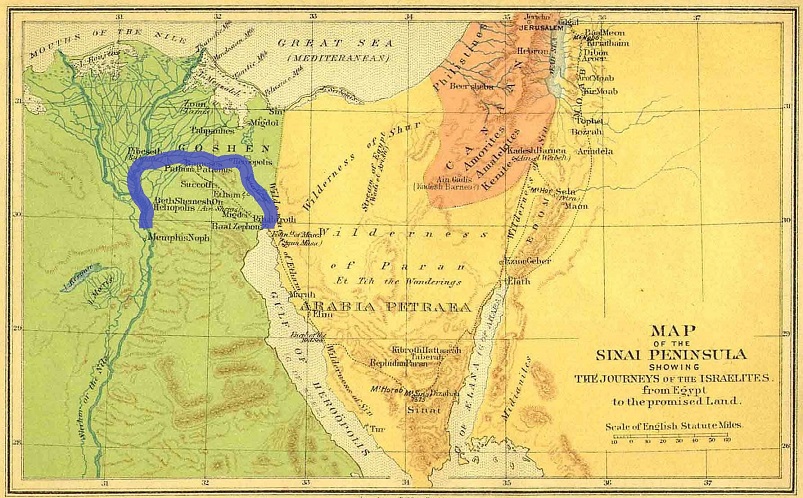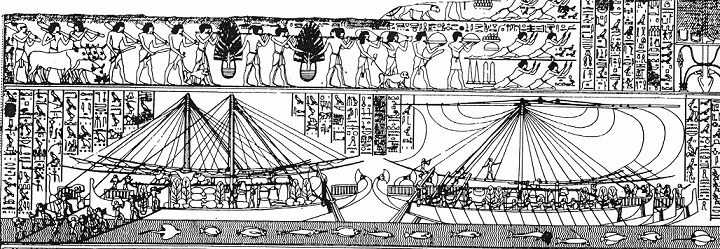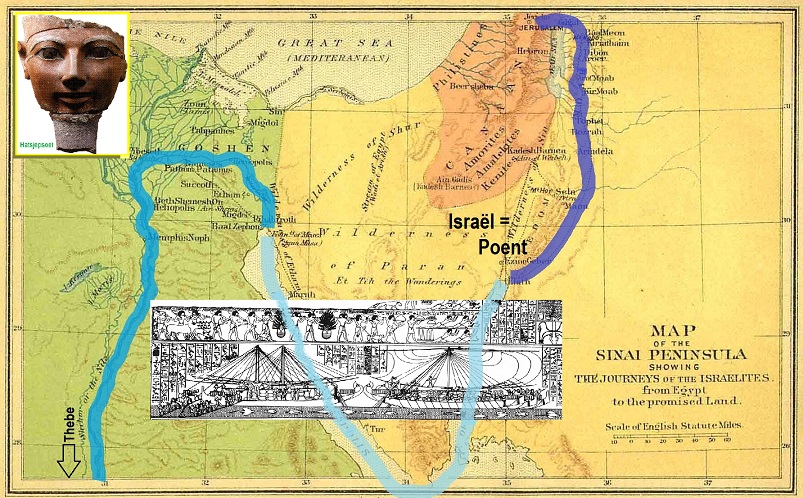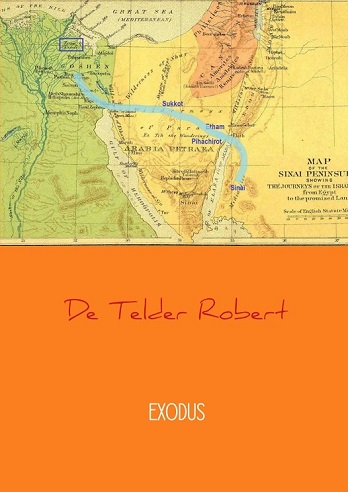Herodotos Boek 2:158. The son of Psammetichos was Necos, and he became king of Egypt. This man was the first
who attempted the channel leading to the
Erythraian Sea, which Dareios the Persian afterwards completed: the length of this is a voyage of four days,
and in breadth it was so dug that two triremes
could go side by side driven by oars; and the water is brought into it from the
Nile. The channel is conducted a little
above the city of Bubastis by Patumos the Arabian city, and runs into the Erythraian Sea: and
it is dug first along those parts of the plain of Egypt which lie towards
Arabia, just above which run the mountains which extend opposite Memphis, where are the stone-quarries,--along the base of
these mountains the channel is conducted
from West to East for a great way; and after that it is directed towards a
break in the hills and tends from these mountains towards the noon-day and the
South Wind to the Arabian gulf.

Now in the place where the journey is least and
shortest from the Northern to the
Southern Sea (which is also called Erythraian), that is from Mount Casion,
which is the boundary between Egypt and Syria, the distance is exactly a
thousand furlongs to the Arabian gulf; but the channel is much longer, since it
is more winding; and in the reign of Necos there perished while digging it
twelve myriads of the Egyptians. Now Necos ceased in the midst of his digging,
because the utterance of an Oracle impeded him, which was to the effect that he
was working for the Barbarian: and the Egyptians call all men Barbarians who do
not agree with them in speech.
De
oudheidhistoricus Herodotos bezocht Egypte in de vijfde eeuw v. Chr. en
verhaalt in zijn werk over het kanaal van de Nijl naar de Eritreïsche- of Rode
Zee dat onder farao Neko gegraven werd en later door de Perzische koning Darius
I afgemaakt. Op de bijgevoegde kaart heb ik het traject van het oudheidkanaal
met een blauwe lijn uitgebeeld. Het kanaal was breed genoeg om twee triëren
naast elkaar door te laten. Triëren waren Egyptische oorlogsschepen van
ongeveer veertig meter lang en drie tot vier meter breed, met een diepgang van
negentig tot honderdtwintig centimeter. Aan beide zijden zaten in drie rijen
een totaal van 174 roeiers. Vierendertig soldaten plus vijftien bemanningsleden
vervolledigden de bemanning.
Farao
Neko II van Manetho s zesentwintigste dynastie regeerde over Egypte van 621
tot 605 v. Chr. Het begin van het graven van het Suezkanaal van de oudheid
plaatsen we aldus aan het einde van de zevende eeuw v. Chr. De zesentwintigste
dynastie en farao Neko II had mijn aandacht in mijn boek TIJD en TIJDEN, 2015, blz. 375-384. Deze farao staat bij naam in de
Bijbel vermeld en was degene die koning Josia van Juda te Megiddo in 609 v.
Chr. doodde (TIJD en TIJDEN, 2015, blz. 361-365).
De
zesentwintigste dynastie was de laatste soevereine Egyptische dynastie alvorens
het land door Meden en Perzen onder de voet gelopen zou worden. Daarna volgde
voor Egypte de Griekse periode en nog later ving de Romeinse periode aan.
Het
graven van een kanaal van de Nijl naar de Rode Zee wordt echter ook door de
farao s Seti I en Ramses II van de negentiende dynastie geclaimd. Voor Dr. I.
Velikovsky was dit een van de vele aanwijzingen dat de farao s van de
negentiende dynastie alter ego s van de farao s van de zesentwintigste
dynastie waren.
Het oorspronkelijke
kanaal is echter vermoedelijk nog veel ouder en dateert uit de tijd van Hatsjepsoet, de vrouwfarao van de
achttiende dynastie. Het is een studie van de Egyptologe Amelia Ann Blanford Edwards (1831-1892) dat ik op het internet
vond, dat de aanleiding tot het schrijven van dit artikel werd. Volgens deze
studie dateert het kanaal waar Herodotos naar verwijst, naar de tijd van Hatsjepsoet.
Een vrouw op de troon van Egypte, waar de Egyptische (mannelijke) priesters met
wie Herodotos in de vijfde eeuw v. Chr. mee sprak, met geen woord over repten.
Het studiewerk van de Egyptologe Amelia Ann Blanford Edwards van de reis van
Hatsjepsoet naar het land Poent is nauwkeurig aan de hand de bewaard gebleven
reliëfs uit haar tempel te Deïr El Bahri, uitgewerkt. De conclusie van haar was
dat er al een kanaal van de Nijl naar de Rode Zee in Hatsjepsoet s tijd
gegraven moest zijn. Hierna het betreffende citaat uit Amelia Ann s studie:
Chapter
8: Queen Hatasu, and Her Expedition to the Land of Punt." By Amelia Ann
Blanford Edwards (1831-1892) VIII.
QUEEN HATASU, AND HER EXPEDITION TO THE LAND OF PUNT.
Before
we go farther on our way towards the Land
of Punt, it will be well
to consider by what route the squadron reached its destination. This is a very
interesting question. Many of the upper courses of these sculptured and painted
walls are so hopelessly mutilated as to break the continuity of the narrative.
Thus, although it is distinctly stated that the ships returned to Thebes and there
disembarked their cargo at the close of the expedition, the inscription which
should inform us as to the point of their departure is lost. Seeing,
however, that they returned to Thebes, it may be
taken for granted that they sailed from the same port, and this supposition is
confirmed by the blue colour of the water and the presence therein of the
fishes of the Nile. But what course did they
take when they had turned their backs upon "hundred-gated Thebes ?"

That
the squadron should have descended the Nile, sailed westward through the Strait
of Gibraltar, skirted the west coast of Africa, doubled the Cape of Good Hope,
and reached the Somali shores by way of the Mozambique Channel and the coast of
Zanzibar is absolutely incredible.
Such
an achievement at so early a stage of naval history, would be
far more wonderful than the building of all the pyramids or temples of Egypt.
It would, in fact, imply that Queen Hatasu's squadron twice made the almost
complete circuit of the African continent. We are compelled to reject this
hypothesis. Rejecting it, we must fall
back upon the only alternative possibility, which is that they went out by some ancient water-way connecting
the Nile with the Red Sea.
Now,
the surveys recently made by Lieutenant-colonel Ardagh, Major Spaight, and
Lieutenant Burton, of the Royal Engineers, have rendered it certain that the
Wady Tûmilât was at some very distant time traversed by a branch of the Nile
which discharged its waters into the Red Seathe majority of geographers being
now of opinion that the head of the Gulf of Suez formerly extended as far
northward as the modern town of Ismaïlia. Whether that branch of the Nile was ever navigable, we know not; but we do know that
it was already canalized in the reign of Seti I, second Pharaoh of the
Nineteenth Dynasty, and father of Rameses II.
This
ancient canal started, like the present
Sweetwater Canal,
from the neighborhood of Bubastis, the modern
Zagazig; threaded the Wady Tûmilât; and emptied itself into that basin which is
now known as Lake
Timsah. When M. de
Lesseps laid down the line of the Sweetwater
Canal, he, in fact,
followed the course of the old canal of the Pharaohs, the bed of which is yet
traceable. When I last saw it, several blocks of the masonry of the old
embankment were yet in situ, among the reeds and weeds by which that
ancient water-way is now choked.
This canal is represented in one of the most celebrated
wall-sculptures of the Great Temple of
Karnak, and it is there called Ta-Tena,
or "the cutting;" and because King Seti is shown to be returning
to Egypt from one of his Syrian campaigns by way of a bridge over this same
canal, it has been universally taken for granted that he was the author of that
important engineering work. There is, however, no kind of evidence to justify
the assumption. As reasonably might it be supposed that
Napoleon the First was the builder of the Pyramids, because in Gérome's great
picture he is represented as seated on horseback, and contemplating them from a
distance. The canal may have existed, and in all probability did
exist, long before the time of Seti I. It would
seem, indeed, as if the great
woman-Pharaoh who first conceived the daring project of launching her ships
upon an unknown sea, was by far the most
likely person to canalize that channel by which alone, so far as we can
see, it would have been possible for them to go forth. For my own part, I have
not the slightest doubt that Queen Hatasu was the scientific ancestress of M.
de Lesseps; and that it was to the genius and energy of this
extraordinary woman that Egypt owed that great work of canalization which first
united the Nile with the Red Sea.
In
the sculptured tableau from which our illustration of the ship is taken, four
other vessels are shown: the first, as we have seen, leads the way with a
swelling sail; the last is not yet fully laden, but lies at anchor, waiting for
a small boat into which some sailors are conveying large jars.
De
Egyptologe Amelia Ann Blanford Edwards (1831-1892) leefde en werkte in een tijd
dat het revisionisme van de geschiedenis van de oudheid en vooral van Egypte, nog
moest opkomen. Voor haar was het onbekende land Poent naar waar Hatsjepsoet een
expeditie uitrustte, het land Somalië aan de oostkust van Afrika. Dit is een
identificatie die de toen nog jonge wetenschap der Egyptologie had aangenomen.
Het was pas in de helft van de twintigste eeuw dat de autodidact Dr. I.
Velikovsky een nieuwe identificatie van het land Poent lanceerde: Israël.
Volgens zijn reconstructie van de geschiedenis van de oudheid waren Hatsjepsoet
en Salomo tijdgenoten en bevriend met elkaar. Het boek van Velikovsky: Ages in Chaos (Eeuwen in chaos), 1952,
hoofdstuk III, blijft een aanrader. Velikovsky toont vanuit verschillende
historische bronnen aan dat Hatsjepsoet in haar negende regeringsjaar Salomo te
Jeruzalem bezocht en dat zij de Bijbelse koningin van Scheba was. Volgens mijn
revisie van de geschiedenis van de oudheid geschiedde dit in het dertigste regeringsjaar
van Salomo, een periode dat al de bouwwerken van Salomo beëindigd waren. Zie
ook het artikel op dit blog van 02.03.2015,
Salomo te Megiddo in het Laat Brons Tijdperk. Zie link:
http://www.bloggen.be/robertdetelder/archief.php?startdatum=1425250800&stopdatum=1425855600
In mijn
boek TIJD en TIJDEN, 2015, blz.
205-210, wordt deze era ook uitvoerig behandelt. In mijn laatste publicatie: Exodus komt Hatsjepsoet ook aan bod
alhoewel er een tijdsperiode van vijf eeuwen met de Exodus is. In
het hoofdstuk: de dochter van farao, maak ik duidelijk dat Hatsjepsoet onmogelijk
als de dochter van de farao van de verdrukking geïdentificeerd kan worden.
Tegelijkertijd breng ik chronologisch de geschiedenis van de farao s van de
achttiende dynastie, hun regeertijden en familiale relaties, die haaks staan op
wat de Bijbel over de farao van de verdrukking te zeggen heeft. Bijbelvorsers
die er vanuit gaan dat de Egyptologie het met haar rangschikken van de
Egyptische dynastieën op de tijdsbalk, bij het rechte eind heeft, moeten de
farao van de verdrukking en diens dochter in de achttiende of negentiende
dynastie zoeken, afhankelijk van hun keuze voor een korte of late datum voor de
Exodus. Hun keuze valt dan wel eens op Hatsjepsoet als dochter van de farao van
de verdrukking. De vader van Hatsjepsoet: Thothmosis I, heeft echter slechts een
regeerperiode van veertien jaar in plaats van de vereiste tachtig jaar, wanneer
men het Bijbelboek Exodus als historisch correct hanteert.
Velikovsky
laat in zijn boek Eeuwen in Chaos Hatsjepsoet een andere reisroute volgen dan
Amelia
Ann Blanford Edwards eerder doorgaf. Velikovsky laat de vrouwfarao van Thebe
naar Coptos en vervolgens naar el-Qoseir, een haven aan de Rode Zee, reizen.
Vandaar laat hij de vloot van Hatsjepsoet naar de golf van Akaba, naar
Ezeon-Geber bij Eloth, varen. De thesis van Amelia Ann Blanford Edwards kende
Velikovsky niet, of wenste hij ze niet te volgen? Amelia Ann Blanford Edwards
had het nochtans bij het juiste eind in haar opmerking dat op basis van haar
onderzoek van de betreffende reliëfs van Hatsjepsoet, dat de vloot wel degelijk
vanuit Thebe was vertrokken en daarna ook in Thebe langs dezelfde route teruggekeerd:
Seeing,
however, that they returned to Thebes, it may be taken for granted that they
sailed from the same port, and this supposition is confirmed by the blue colour
of the water and the presence therein of the fishes of the Nile. But what
course did they take when they had turned their backs upon "hundred-gated
Thebes ?"

En dat
is alleen mogelijk indien zij ook een kanaal van de Nijl naar de Rode Zee had laten
graven, of zoals Amelia Ann Blanford Edwards zelf opmerkte:
For my
own part, I have not the slightest doubt that Queen Hatasu was the scientific
ancestress of M. de Lesseps; and that it was to the genius and energy of this
extraordinary woman that Egypt owed that great work of canalization which first
united the Nile with the Red Sea.
Absoluut
bewijs hebben we echter niet. De schuld hiervan ligt bij haar opvolger
Thothmosis III die na haar dood in 964 v. Chr. een damnatio memoriae naar
haar persoon doorvoerde en de nodige vernielingen liet uitvoeren. Of hoe
boeiend het revisionisme van de geschiedenis van de oudheid is en blijft.
Wordt
vervolgd
Met
vriendelijke groet,
Robert
De Telder
Recente publicaties van Robert De Telder
EXODUS, 2016, zie link: http://www.bravenewbooks.nl/books/102331
De Zonaanbidder, 2016, zie link: http://www.bravenewbooks.nl/books/87999

TIJD en TIJDEN, 2015, Zie link: http://boekscout.nl/shop/ViewProduct.aspx?bookId=5579
De Assyriologie herzien, 2012, zie link: http://www.bravenewbooks.nl/books/76234
De Tweede Wereldoorlog door de ogen van een neutrale
Belg, 2007, zie link: http://www.bravenewbooks.nl/books/69343

